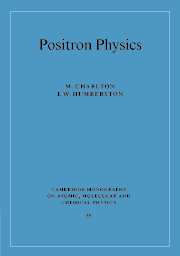Book contents
7 - Positronium and its interactions
Published online by Cambridge University Press: 15 August 2009
Summary
In this chapter we consider the physics of the positronium atom and what is known, both theoretically and experimentally, of its interactions with other atomic and molecular species. The basic properties of positronium have been briefly mentioned in subsection 1.2.2 and will not be repeated here. Similarly, positronium production in the collisions of positrons with gases, and within and at the surface of solids, has been reviewed in section 1.5 and in Chapter 4. Some of the experimental methods, e.g. lifetime spectroscopy and angular correlation studies of the annihilation radiation, which are used to derive information on positronium interactions, have also been described previously. These will be of most relevance to the discussion in sections 7.3–7.5 on annihilation, slowing down and bound states. Techniques for the production of beams of positronium atoms were introduced in section 1.5. We describe here in more detail the method which has allowed measurements of positronium scattering cross sections to be made over a range of kinetic energies, typically from a few eV up to 100–200 eV, and the first such studies are summarized in section 7.6.
Important advances continue to be made in measurements of the intrinsic properties of the positronium atom, e.g. its ground state lifetimes (Rich, 1981; Al-Ramadhan and Gidley, 1994; Asai, Orito and Shinohara, 1995) and various spectroscopic quantities (Berko and Pendleton, 1980, Mills, 1993; Hagena et al., 1993). These are reviewed in section 7.1.
- Type
- Chapter
- Information
- Positron Physics , pp. 307 - 361Publisher: Cambridge University PressPrint publication year: 2000

